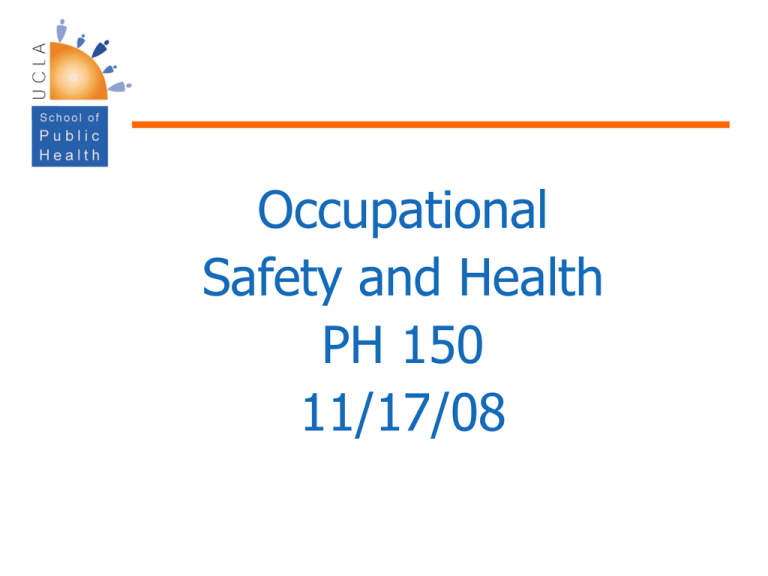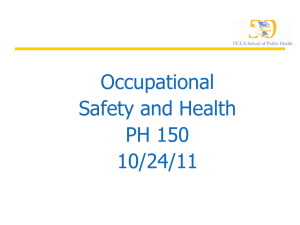Health care - UCLA School of Public Health
advertisement

Occupational Safety and Health PH 150 11/17/08 Population Health Focuses on improving health of communities – saves lives millions at a time, not just one at a time Prevents disease and disability Promotes healthy environments and behaviors Assures high quality, cost-effective health care Linkages and Overlaps Public/Health Care Systems Population Health Personal Health 20th Century Advancements In the 20th Century public health worked hand in hand with medical advances to: Decrease infant mortality by 99% Reduce the incidence of coronary disease by 51% Eradicate many crippling and deadly infectious diseases Add 25 years to our lifespan Investments Not Effectively Targeted The 97/3 Problem Population Health 3% Health care 97% Investments Not Effectively Targeted Value of Investment Population Health Individual Healthcare …”the one thing that we all really care about: a medical system that focuses on our lifelong health and prioritizes prevention as much as it does treatment.” Bill Gates, Wall Street Journal, 10/05/07 An Ecological Model of Health Population health modeled on evidence that there are multiple determinants of health Medical care Behavior Biology (genetics) Physical environment Social environment Education Socioeconomic Status Employment Housing Magnitude of the Problem 10 million work-related injuries/year 430,000 new work-related diseases/year Each day: 9,000 sustain disabling injuries 16 die from injury 137 die from work-related disease Annual Toll of Occupational Injury and Illness Injuries Fatal Non-fatal* Total costs Diseases Fatal** Non-fatal Total costs * 46% disabling (6.09 million) ** Based on cancer, cardiovascular disease, chronic respiratory disease, neurologic and renal disorders 6,529 13.25 million $145 billion 60,300 862,200 $26 billion Costs in Billions Annual Economic Burden of Disease and Injury 200 180 160 140 120 100 80 60 40 20 0 171 164 170.7 Circulatory Diseases Cancer 67.3 33 Occupational Diseases and Injuries 1997; Leigh et al. Arch Int Med. AIDS Alzheimer Disease Global Burden of Occupational Injury and Illness Among 2.7 billion workers Each year: 2 million deaths from disease and injury 270 million workers sustain nonfatal injuries 12 million injuries among youth workers (12,000 fatal) 4% gross domestic product (GDP) lost per year Occupational Risk Hazards Attributable Fraction (%) of Global Disease and Injury Due to Occupational Risk Factors 32 Low Back Pain (37) 41 11 Hearing Loss (16) 22 6 COPD (13) 18 7 Asthma (11) 14 Unintentional Injuries (10) 2 15 Trachea, bronchus or lung cancer (9) 5 10 2 2 Leukemia (2) 0 10 20 Male 30 Female 40 50 THE US WORKFORCE Size of workforce: Unionized: Unemployed: 140 million 12% 6.5% Changing Demographics Projected Changes in Civilian Labor Force 2004 to 2014 2004 50 45 40 35 30 25 20 15 10 5 0 2014 46.8 46.4 35.7 31 21.2 15.6 Minorities Over Age 55 Women Women Participating in the Global Workforce Developed Countries Sweden and Denmark United States France and Germany Switzerland Netherlands Italy Spain Source ILO, 1995 % of women who work 75% 60% 57% 53% 38% 37% 26% Women Participating in the Global Workforce Developing Countries China Mozambique Vietnam Thailand Brazil and Chile Mexico /Argentina Egypt, Saudi Arabia, Oman, and Jordan Algeria * Includes the informal workforce % of women who work* 80% 78% 77% 67% 33% 32% 10% 8% Source, ILO, 1995 Aging Workforce Workers Over Age 60 20 percent 15 1995 2030 10 5 0 Japan Source Health Affairs, May/June 2000 U.S. France Projected Changes in Employment by Industry 80 Percent of Total 70 60 50 1986 1996 2006 40 30 20 10 0 Goods Producing Source: Franklin, 1997 Service Producing Growth of the Contingent Workforce 30 Millions 25 20 15 10 5 19 70 19 75 19 80 19 85 19 90 19 95 20 00 20 05 0 Source: Bureau of Labor Statistics Temporary employees Part-time workers Multiple-job holders Self-employed workers Informal Sector Majority of new jobs in developing countries Subcontracting Household-based Independent, cater to markets at low end of income scale Unpaid female labor, family members Independent service sub-sector ILO 1999 Bulk of informal sector, lowest skills Maids, street vendors, cleaners, casual unskilled laborers Informal Workforce (% of Total Urban Employment) ILO 1999/WHO 1995 Africa – 60% Bolivia and Madagascar– 57% Tanzania – 56% Colombia – 53% Thailand – 48% Venezuela – 46% Industrialized Countries – 5-10% Annual Hours Worked United States 1,966 Japan 1,889 Canada 1,732 Britain 1,731 Norway 1,399 0 500 1,000 1,500 2,000 Average annual number of hours worked per person Source: International Labor Organization (1999) 2,500 Changing Nature of Work: Increased Stress Three-fourths of employees believe the worker has more on-the-job stress than a generation ago Work Organization/Stress Severity of the Problem No good surveillance systems and few studies in the U.S. Estimated 13% of U.S. worker compensation claims are for stress-related disorders 27% of U.S. workers reported jobs are greatest single source of stress 60% sampled women workers cited job stress as biggest problem at work Employment Trends Index (ETI) and Labor-Market Indicators Percentage saying “jobs hard to get” Initial claims for unemployment insurance Percentage of firms with one or more jobs open Number of employees hired by temporaryhelp industry Part-time workers for economic reasons Job openings Industrial production Real manufacturing and trade sales U.S. Health System: You Don’t Get What You Pay For Highly fragmented at all levels Most expensive (16.3% of gross domestic product) One of least accessible (48 million uninsured, more underinsured) U.S. pays for half of all personal health care (e.g. Medicare/Medicaid, DOD, VA, federal worker insurance) U.S. Health System: You Don’t Get What You Pay For, con’t. WHO ranked 191 countries U.S. 37th in overall performance U.S. 24th in overall health attainment U.S. among its peers Of 29 countries in OECD—Organization for Economic Cooperation and Development Ranked 23rd in infant mortality Ranked 21st in male life expectancy Met only 15% of Healthy People 2000 objectives (deteriorated in 20% of objectives) Does Being Uninsured Matter? YES 20% uninsured (vs. 3% insured) did not get medical care for a serious medical problem 30% uninsured (vs. 12%) did not fill a prescription 39% uninsured (vs. 13%) skipped a recommended test or treatment 13% (vs. 4%) had trouble getting mental health care Percent Employer-Sponsored Health Insurance 72 70 68 66 64 62 60 58 56 54 52 1987 1991 Source: U.S. Census Bureau/ Kaiser Family Foundation 1995 1999 2003 2006 Insurance for Work-Related Conditions Workers’ compensation no fault, state by state Illnesses > injuries often contested Worker may be uninsured or underinsured for set of conditions despite being deemed fully insured Occupational Injuries in U.S. Incidence rates of nonfatal occupational injuries (total recordable cases) by selected industry sectors, 1980 - 2000 20 Injury rate per 100 full-time workers 18 16 14 12 10 8 6 Agricultural production Construction 4 Nursing and personal care 2 0 1980 1981 1982 1983 1984 1985 1986 1987 1988 1989 1990 1991 1992 1993 1994 1995 1996 1997 1998 1999 2000 Year Health Care Industry Health care workers = 8% of U.S. workforce 1996-2006: 2 of the 4 fastest growing industries are HC-related (health services and health practitioners’ offices) Health care services are growing at twice the rate of the overall economy Health Care Worker Hazards Biological hazards bacteria, viruses, fungi, parasites Chemical hazards medications, solutions, gases Physical hazards radiation, electricity, extreme temperatures, noise, lifting Psychosocial hazards factors causing stress, emotional strain, interpersonal problems Needlestick Injuries Exposure to bloodborne pathogens (HIV, Hepatitis B, and Hepatitis C) In the United States, approximately 800,000 needlestick injuries occur in hospitals annually -- an average of one injury every 10 seconds 1/3 of all sharps injuries have been reported to occur during disposal activities Infections in Health Care Workers (35 million worldwide) Percentage Attributable fraction of Hep C, Hep B and HIV Attributable fraction of Hep care C, Hepworkers B and HIVdue infections in healthcare infections in health to injuries workers due to ages injuries with contaminated sharps, ages 20-65 with sharps, 20-65 100% 90% 80% 70% 60% 50% 40% 30% 20% 10% 0% HCV HBV HIV Africa Americas E Med. Europe SE Asia W Pacific Overall: of all Hep B&C, ~40% due to sharps Of all HIV, about 1 – 12% due to sharps Occupations of Victims of Nonfatal Workplace Violence 1992-96 Occupation Total Annual Average 2,009,400 # per 1,000 Workers 14.8 10,000 69,500 24,500 56,800 15.7 24.8 21.4 10.7 50,300 8,700 43,500 79.5 63.3 64.0 Medical Physicians Nurses Technicians Other Mental Health Professional Custodial Other Source: Bureau of Justice Statistics, 1998 BLS Data on Nonfatal Workplace Assaults, by Source of Injury (1995) Health Care Patient, 51% Worker/ Former Coworker, 8% Other Person, 29% Other Source, 12% Work Organization Stressors in Health Care Settings Death and dying Floating Work overload Work environment Family stress Role conflict Shiftwork Effects of Medical Error IOM estimates that medical errors cause 44,00098,000 deaths annually Medical error = 8th leading cause of U.S. deaths Medical error causes more deaths than auto accidents, breast cancer and AIDS Chicago Tribune: “To compensate for understaffing, hospitals often rely on machines with warning alarms to help monitor patients’ vital signs. At least 216 patient deaths and 429 injuries have occurred in hospitals where registered nurses failed to hear alarms built into lifesaving equipment, such as respirators and blood-oxygen monitors.” More registered nurses are associated with shorter length of stay and fewer complications Outcome %Lower Length of Stay 3.5% Urinary Tract Infection Upper Gastrointestinal Bleeding 9.0% Pneumonia 6.4% Shock/Cardiac Arrest 9.4% Failure to Rescue 3.9% Source: Needleman et al., Nurse-Staffing Levels and Quality of Care in Hospitals, NEJM, 2002 5.1% Hospital Nurse Staffing and Patient Mortality, Nurse Buyout and Job Dissatisfaction Design: Linked data from discharge of 168 adult hospitals in PA, 10,000 nurses (random survey), 230,000 patients Results: Nurses – 94% women 43% high emotional exhaustion 42% dissatisfaction with current job Source: Aiken et al. JAMA 2002; 288:1987-93 After adjustment for patient and hospital characteristics, each additional patient per nurse → 23% ↑ burnout 15% ↑ job dissatisfaction 7% ↑ patient mortality Fewer People, Same Work Work organization factors Downsizing Deskilling and collapsing of job titles More patients at higher acuity levels Decline of non-profit facilities Fewer people + same work added stress and fatigue compromised patient care Improving Worker Health and Safety Leads To: Improved health status Decreased health care/related costs Increased productivity Increased quality Job Creation 1992-2008 The Last Eight Years Worker productivity (2000-2007) 20% Real income working, middle-class households ( $2,000) 3% The Next Four Years Job Creation – Infrastructure Support Education Health and Health Care Energy/Transportation Research


